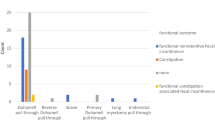Abstract
Hirschsprung’s disease (HD) in Down’s syndrome (DS) patients is stated to have a worse outcome than HD alone. In our study we reviewed the immediate and long-term outcomes of these children and questioned whether DS should influence the operative management. Data were collected on all children with HD (including total colonic aganglionosis), between January 1990 and December 2000. They were divided into two groups based on the presence or absence of Trisomy 21 and compared retrospectively. In this time period we treated 173 children with HD; 17 of these had DS. Both the groups were comparable in their mean gestational age, birth weight and presentation except that the DS group had a significantly higher overall incidence of pre and/or postoperative enterocolitis. A tota1 of 164 children underwent a Swenson pull-through and 9 had a Soave’s procedure. Follow-up ranged from 1 to 10 years. Continence assessed using the Wingspread scoring system in children over the age of 4 years showed no significant difference. Although children with both HD and DS are predisposed to complications and required a more cautious management, long-term outcome in terms of continence was not significantly worse than in HD alone. Thus the co-existence of DS should not influence the decision to offer these children and their parents the choice of definitive repair.
Similar content being viewed by others
References
Quinn FM, Surana R, Puri P (1994) The influence of trisomy 21 on outcome in children with Hirschsprung’s disease. J Pediatr Surg 29(6):781–783
Hackham DJ, Reblock K, Barksdale EM, Redlinger R, Lynch J, Gaines BA (2003) The influence of Down’s syndrome on the management and outcome of children with Hirschsprung’s disease. J Pediatr Surg 38(6):946–949
Caniano DA, Teitelbaum DH, Qualman SJ (1990) Management of Hirschsprung’s disease in children with trisomy 21. Ann J Surg 159(4):402–404
Stephen FD, Durham-Smith E (1986) Classification, identification and assessment of surgical treatment of anorectal anomalies (“Wingspread classification”). Paediatr Surg Int 1:200–205
Goldberg EL (1984) An epidemiological study of Hirschsprung’s disease. Int J Epidemiol 13(4):479–485
Moore SW, Albertyn R, Cywes S (1996) Clinical outcome and long-term quality of life after surgical correction of Hirschsprung’s disease. J Pediatr Surg 31(11):1496–1506
Teitelbaum DH, Qualman SJ, Caniano DA (1998) Hirschsprung’s disease, identification of risk factors. Ann Surg 207:240–244
Levin S (1987) The immune system and susceptibility to infections in Down’s syndrome. Prog Clin Biol Res 246:143–162
Wilcox DT, Bruce J, Bowen JC, Bianchi A (1997) One-stage neonatal pull-through to treat Hirschsprung’s disease. J Pediatr Surg 32(2):243–247
Author information
Authors and Affiliations
Corresponding author
Rights and permissions
About this article
Cite this article
Morabito, A., Lall, A., Gull, S. et al. The impact of Down’s syndrome on the immediate and long-term outcomes of children with Hirschsprung’s disease. Ped Surgery Int 22, 179–181 (2006). https://doi.org/10.1007/s00383-005-1617-0
Accepted:
Published:
Issue Date:
DOI: https://doi.org/10.1007/s00383-005-1617-0




